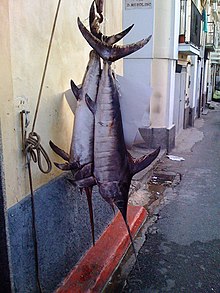Fish stocks

as reported byFAO1974-2015
Fish stocksaresubpopulationsof a particularspeciesoffish,for which intrinsic parameters (growth, recruitment, mortality and fishing mortality) are traditionally regarded as the significant factors determining thestock's population dynamics,while extrinsic factors (immigration and emigration) are traditionally ignored.
Concepts[edit]
The stock concept[edit]
All species have geographic limits to their distribution, which are determined by theirtolerancetoenvironmentalconditions, and their ability tocompetesuccessfully with other species. Inmarineenvironments this may be less evident than on land because there are fewertopographicalboundaries, however, discontinuities still exist, produced for example by mesoscale and sub-mesoscale circulations that minimize long-distance dispersal of fish larvae.
For fish, it is rare for an individual to reproduce randomly with all other individuals of that species within its biological range. There is a tendency to form a structured series of discrete populations which have a degree of reproductive isolation from each other in space, in time, or in both. This isolation is reflected in the development between sub-populations ofgeneticdifferences,morphologicalvariations and exposure to differentchemicalregimes andparasiticspecies. Sub-populations also respond to fishing in such a way that fishing on one population appears to have no effect on the population dynamics of a neighbouring population.
The currently accepted definition of a stock in fisheries science, is that of Begg et al. (1999),“…[a “stock” ] describes characteristics of semi-discrete groups of fish with some definable attributes which are of interest to fishery managers.”

Stock identification is a field offisheries sciencewhich aims to identify these subpopulations, based on a number of techniques.This concept is applied insustainable development goal 14where target 14.4 is measured a fish stock sustainability indicator 14.4.1.[1]
Straddling stock[edit]

TheUnited Nationsdefines straddling stocks as "stocks of fish such aspollock,which migrate between, or occur in both, theeconomic exclusion zones(EEZ) of one or more states and thehigh seas".[2]Sovereign responsibility must be worked out in collaboration with neighbouringcoastal statesand fishing entities. Usually this is done through the medium of an intergovernmental regional organisation set up for the purpose ofcoordinating the managementof that stock.
Straddling stocks are usuallypelagic,rather thandemersal.Demersal species move less than pelagic species, since they tend to relate to bottom topography. Pelagic species are more mobile, their movements influenced by ocean temperatures and the availability of zooplankton as food. Example pelagic fish arecapelin,herring,whiting,mackerelandredfish,There are, however, a few demersal species that are straddling, such as theGreenland halibutmigrates in feeding/spawning migrations to Greenland in the west and to theFaeroesin the east.[3]
Straddling stock can be compared withtransboundary stock.Straddling stock range both within anEEZas well as in the high seas. Transboundary stock range in the EEZs of at least two countries. A stock can be both transboundary and straddling.[4]
Assessment[edit]

Infisheries scienceandecology,stock assessmentis an important tool infisheries management.
In particular, to ensure continued, healthy, fish stocks, measurements of theSpawningStockBiomass(the stock population capable of reproducing) allows sensibleconservationstrategies to be developed and maintained through the application of sustainablefishing quotas.[5]
TheWorld Wildlife Fundand theZoological Society of Londonjointly issued their "Living Blue Planet Report" on 16 September 2015 which states that there was a dramatic fall of 74% in world-wide stocks of the important scombridae fish such asmackerel,tunaandbonitosbetween 1970 and 2010, and the global overall "population sizes of mammals, birds, reptiles, amphibians and fish fell by half on average in just 40 years."[6]It is hoped that global efforts like the United NationsSustainable Development Goal 14meets its targets aimed at reversing these trends.[7]
Fluctuations[edit]

The stocks for individual marine species can "boom and bust" in linked and compensatory ways. For example, inbillfishlonglinefisheries, the Atlantic catch of blue marlin declined in the 1960s. This was accompanied by an increase in sailfish catch. The sailfish catch then declined from the end of the 1970s to the end of the 1980s, compensated by an increase in swordfish catch. As a result, the overall billfish catch remained fairly stable. AtGeorges Bank,a decline in cod during the 1960s was accompanied by a rise in flatfish, and more recently, with the collapse of the predatory Atlantic cod, lobster catches inMainehave boomed.[8]
See also[edit]
References[edit]
- ^"sustainable development goals".
- ^Straddling stocksArchived2015-06-03 at theWayback Machine
- ^Pelagic and straddling stocks
- ^FAO(2007)Report of the FAO workshop on vulnerable ecosystems and destructive fishing in deep sea fisheries[permanent dead link]Rome, Fisheries Report No. 829.
- ^International Council for the Exploration of the Sea (ICES) websiteArchived2011-06-12 at theWayback Machine
- ^Living Blue Planet Reportwwf.org.au September 2015 Archived2015-09-26 at theWayback Machine
- ^"Goal 14 targets".UNDP.Archived fromthe originalon 2020-09-30.Retrieved2020-09-24.
- ^Duffy, J. Emmett (2008)Marine biodiversity and food securityEncyclopedia of Earth.Updated 25 July 2008.
Further reading[edit]
- Begg GA, Friedland KD and Pearce JB (1999) "Stock identification and its role in stock assessment and fisheries management: an overview."Fisheries Research,43:1–8.
- Booke HE (1999)"The stock concept revisited: perspectives on its history in fisheries"Fisheries Research,43(1–3): 9–11.doi:10.1016/S0165-7836(99)00063-6
- Cadrin SX, Friedland KD and Waldman JR (2004)Stock Identification Methods: Applications in Fishery Science.ISBN0-12-154351-X
- Pintassilgo, P and Lindroos, M"Management of Straddling Fish Stocks: A Bioeconomic Approach"In:Encyclopedia of Life Support Systems – Volume 5,UNESCO.
External links[edit]
- Identification of stocks of horse macekerel,Trachurus trachurus
- Identification of stocks of herring,Clupea harengus
- FAO Fisheries DepartmentArchived2008-07-06 at theWayback Machineand itsSOFIA reportArchived2010-06-10 at theWayback Machineaddressing fish stocks



